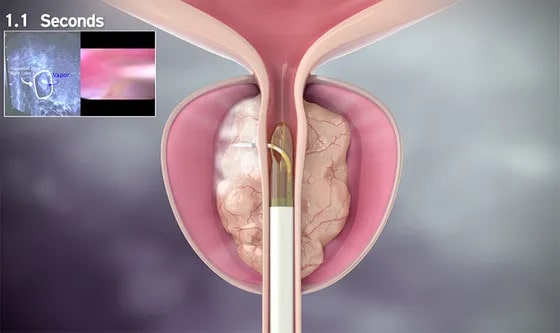REZUM Therapy for Enlarged Prostate
What is Rezum Therapy?
Rezum therapy is a new minimally invasive transurethral method of treatment for enlarged prostate, also known as benign prostatic hyperplasia (BPH).
How Does Rezum Therapy Work?
Rezum therapy works by using thermal energy produced by water vapour to treat the hyperplastic prostate tissue, which is responsible for BPH symptoms.


Benefits of Rezum Therapy
Rezum therapy for BPH has a lot of benefits and minimal transient side effects during the surgical procedure.
Rezum therapy as a procedure in some cases is preferable over other BPH treatments as it offers the following benefits:
- Minimal sexual dysfunction (ie Preserves ejaculation).
- A day case procedure, in an out-patient setting.
- Cost-effective
- Does not take very long
- Improves symptoms within two to four weeks.
Preparation Before Rezum Therapy
In order to prepare for the surgery, the patient should be adequately counselled to ensure that the informed consent obtained is fully understood.
Dr Kim then runs a number of tests to ensure that the patient is fit and in good health for the surgery. These will include
- IPSS score,
- Pathology tests,
- Urine analysis,
- PSA test,
- Uroflowmetry test +/- urodynamics
- Renal tract Ultrasound scans
Before surgery, Flexible Cystoscopy may also be performed to assess prostate enlargement and exclude other pathology (ie. bladder tumour).
Steps in Rezum Therapy
In preparation for the surgery, an IV line is inserted in his arm. The anaesthesia administered will either be general or spinal in nature, which is decided by the anaesthetist and surgeon on a case by case basis.
The surgical device required for this operation is a transurethral delivery and a radiofrequency (RF) generator. This transurethral wand also incorporates a standard cystoscopy lens and a retractable vapour needle that delivers the water vapour.
Rezum surgery treats the additional prostate gland tissue by ‘convective water vapour energy (WAVE)®’
The surgery includes the following steps:
- The patient is positioned on his back and is administered anaesthesia. Although it can be performed under sedation, it is typically performed under general anaesthesia in Australia.
- The legs of the patient are placed in stirrups and elevated and spread apart (lithotomy position)
- The transurethral device is inserted and the convective water vapour energy is applied to produce water vapour, which is delivered to the treatment site via the retractable vapour needle.
- Each area is treated in 9-second bursts, and the water vapour on contact with prostate tissues causes immediate cell necrosis.
- Once the procedure is completed, a soft catheter is placed into the bladder of the patient. This helps in urination.
- The patient is then placed in post-operative care
Recovery After Rezum Therapy
The patient is kept in the recovery room for observation and their vitals are monitored.
Pain medication is administered as needed via IV lines if required. In a few hours, the patient is discharged home if well.
The catheter is required and is generally kept in place for 3-7 days after surgery due to prostate swelling. This ensures that urine can pass without problems. The longer catheter duration and higher risk of infection compared to other surgical procedures is one of the main downsides of REZUM. As the recovery progresses, the catheter is removed. Other potential risks include but are not limited to painful urination (dysuria), blood in the urine (haematuria), blood in the semen (hematospermia), urinary tract infection (UTI), and urinary frequency, retention or urgency as well as small chance of loss or decrease in ejaculatory volume. Patients should talk with Dr Kim about benefits and risks before moving forward with any treatment option.
Patients can return to their regular daily life activities within a few days of the procedure. Pain medication can also be taken on an as per need basis.
Post-Rezum Therapy Care Plan
A care plan will be devised for the patient for the next few months, to aid in recovery and to help improve bladder control.
Dr Kim and his team will also advise a follow-up visit chart to check the patient progress in the clinic as well and to check for any post-surgical complications.
